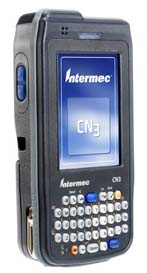Note: On December 10, 2012, Intermec announced that it will be acquired by Honeywell. [See Intermec press release]
Designed to meet the needs of mobile workers in mission-critical transportation, logistics, and field service applications, the Intermec CN3 is a modern, ruggedized handheld computer that combines several functions. It is a conventional PDA, but can also be, depending on options, a scanner, digital camera, phone, and data communications device.  Built to survive fairly severe punishment, the CN3 remains fairly small and handy, with a footprint of 3.2 x 6.3 inches, a thickness of 1.1 inches, and a weight of just under one pound.
Built to survive fairly severe punishment, the CN3 remains fairly small and handy, with a footprint of 3.2 x 6.3 inches, a thickness of 1.1 inches, and a weight of just under one pound.
The CN3 comes with integrated Bluetooth 2.0 an can be ordered with 802.11b/g WiFi and an integrated 1D/2D area imager that supports omnidirectional 1D, 2D, composite and postal decoding as well as signature capture. Customers can also order the CN3 with a GPS receiver with integrated antenna, a 2.0 megapixel digital camera, and either GSM/GPRS/EDGE or CDMA/1xRTT/EV-DO wireless WAN.
The CN3 is available with either a thumb-type QWERTY keyboard or a numeric keypaad, both backlit. Among other accessories are a vehicle dock, single or quad docks that can support LAN, and a magnetic stripe reader.
The device runs Windows Mobile 5.0 on the 520MHz version of the Marvell PXA270 processor, has 128MB of RAM and 256MB of Flash ROMM, a miniSD slot for memory expansion, and 1 3.5-inch 240 x 320 pixel transflective display (full VGA would have been nice).
Also available is the CN3e version that has an enlarged numeric 10-Key or Phone Style backlit keypad for mobile in-field applications that demand intensive key-based data entry.
Overall, the Intermec CN3 allows mobile workers to switch from carrying a number of devices, such as a cellphone, GPS unit, notebook, digital camera, or scanner, and replace them with just one.
Update September 10, 2008: Intermec announced that the CN3 now uses Windows Mobile 6.1 that offers a variety of improvements and advanced features including enhanced virtual memory, increased application speed, faster boot-up and an improved user interface with increased performance and stability.



